Everyone wants an easy solution to the problem of algae in their freshwater aquarium.
The truth is, it is never that simple. While you may hear that this or that fish, snail, or shrimp will be the answer to all your problems, tackling an algal bloom and maintaining algae control needs a multi-faceted approach.
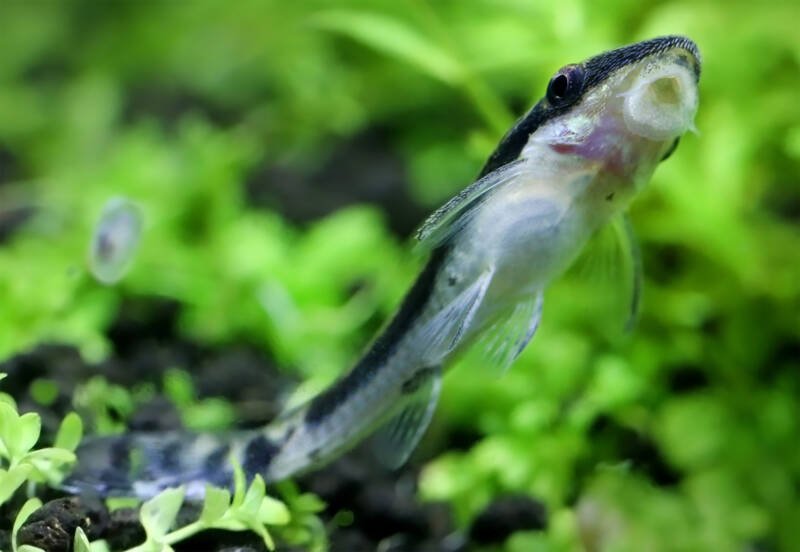
First, determine the underlying problem causing the bloom:
- Are you overfeeding your fish? Feed your fish only the amount they need and remove uneaten food from the tank.
- Are you cleaning your tank adequately/enough? Dirty water provides the right environment for algae blooms. Do a partial water change, and clean the substrate, glass, and decorations. Let the water cycle and assess the algae level again.
- Are you providing too much light to the aquarium? Make sure your aquarium is not located in direct sunlight and reduce artificial lighting if necessary.
- Are your water parameters ideal? Test your water and verify the conditions. Nitrates and ammonia should be zero. Re-set your parameters and hold them steady.
After you have an algal bloom under control, adding algae-eating species to your tank can be part of the solution to maintaining healthy algae levels.
The following species are some of our favorite clean-up crew members.
1. Common Pleco (Hypostomus plecostomus)
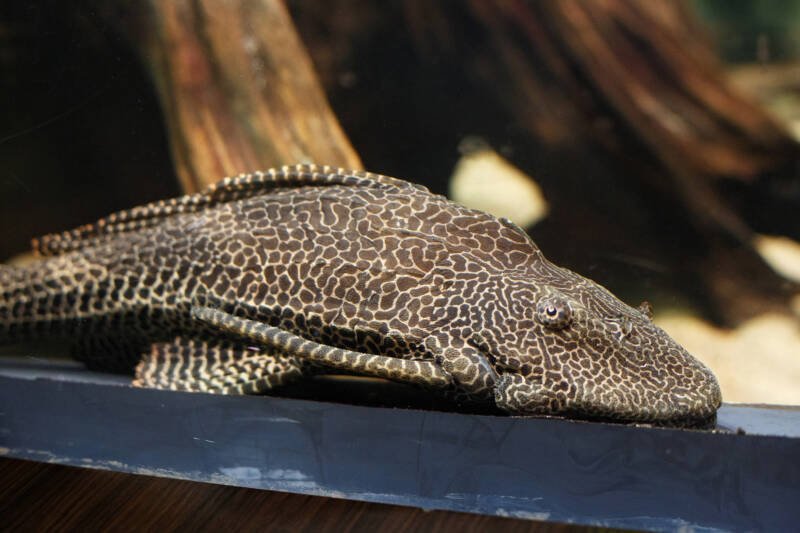
What algae will it eat? String algae, green algae, brown algae
The common pleco is a member of the Loricariidae family of armored catfish.
Although they will consume algae and are often sold as the perfect solution, there are several caveats to consider before purchasing one.
First, their level of consumption changes. Young common plecos will eat algae as a good portion of their diet. However, as they age, they tend to crave more meaty foods and can lose interest in algae altogether.
Second, do not underestimate their adult size. The common pleco can reach up to 15 inches (38 cm) in length by the time they are adults.
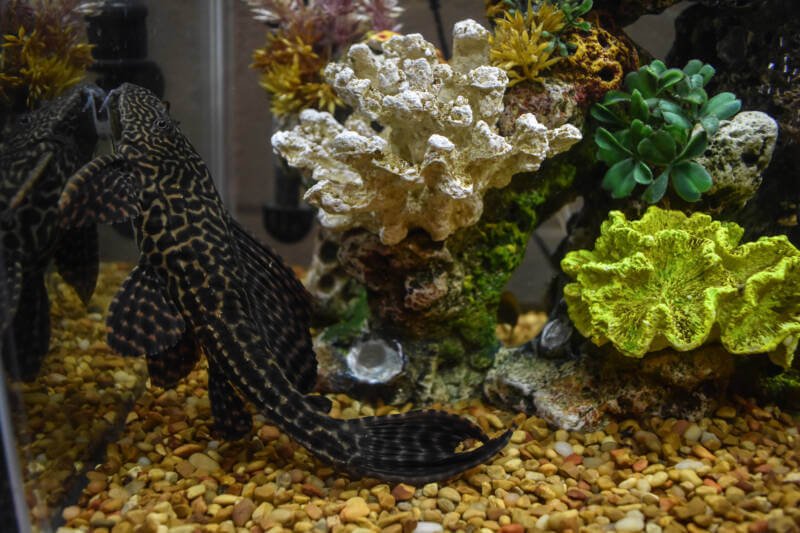
Third, they produce an enormous amount of waste. In fact, they produce so much waste that pleco tanks need sufficient filtering to offset the contaminants.
Finally, these fish are a long-term commitment and can live anywhere from 10 to 15 years. Their aggression can increase as they age, so keep that in mind when selecting tank mates.
2. Otocinclus (genus)
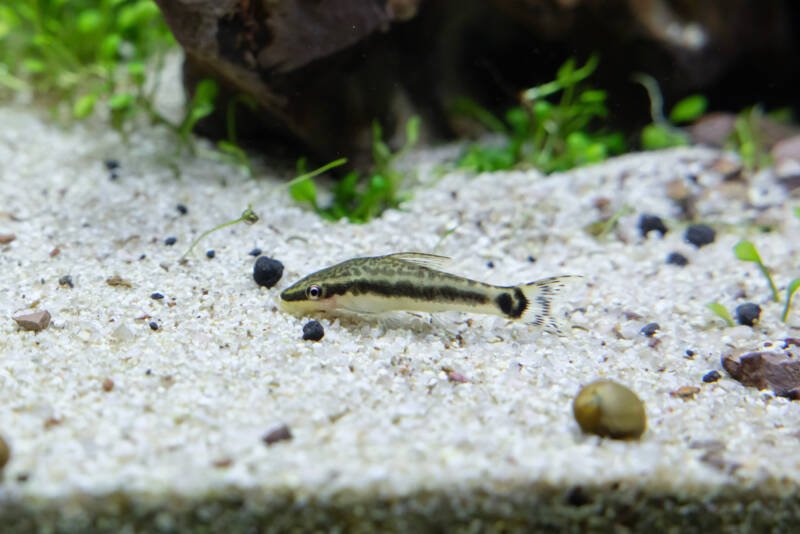
What algae will it eat? Brown algae, green dust algae, green algae, fuzz algae
When it comes to hardiness, ease of care, and algae-eating prowess, look no further than the humble otocinclus.
A long-time aquarium favorite for algae-eating species, it is gentle tempered, small, and readily available in most local fish stores.
While on the shy side, they are great community fish that will be active during the day.
Otos will eat several different types of algae as well as decaying organic matter. They will not tackle black beard or hair algae.
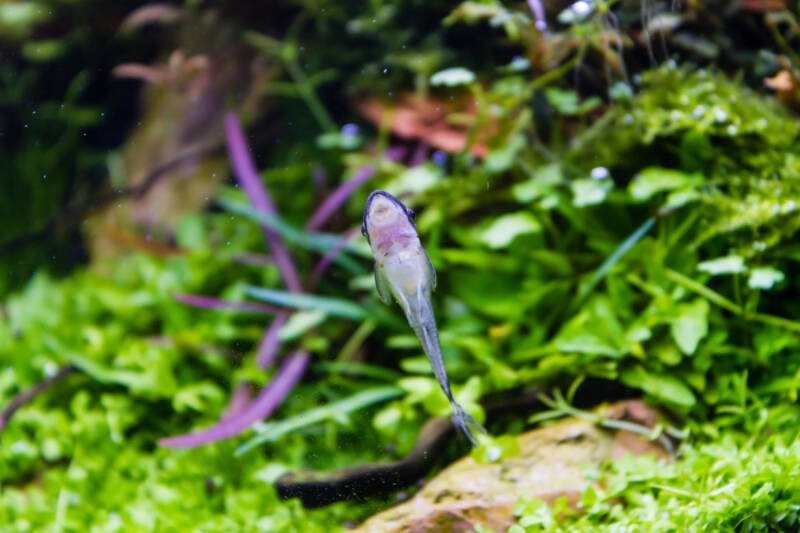
They need a well-established, cycled tank with high oxygen levels and will not tolerate high levels of waste buildup, including ammonia and nitrites.
Keep these schooling fish in a group of four to six for an efficient cleanup crew. Look for tank-raised otos as opposed to wild-caught for better tank acclimation.
3. Bristlenose Pleco (Ancistrus sp.)
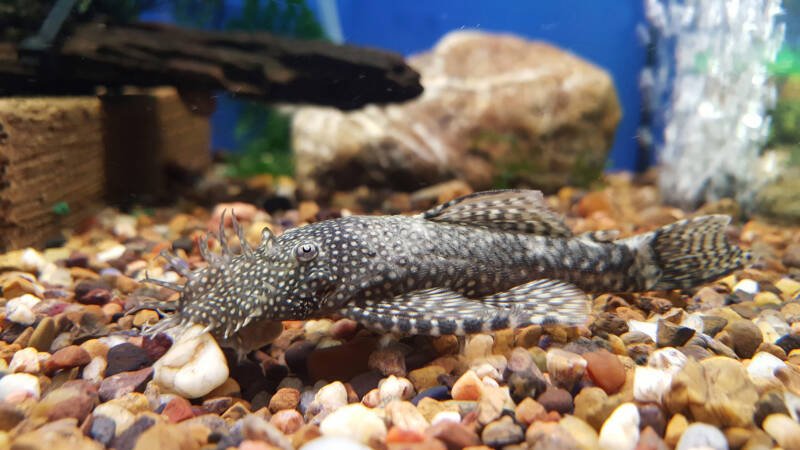
What algae will it eat? Green algae, brown algae, fuzz algae, green dust algae
The bristlenose is mostly an herbivore. They will consume algae and biofilm in large amounts and are experts at cleaning aquarium glass as well as other tank surfaces.
As with the common pleco, younger bristlenose specimens may be more enthusiastic algae cleaners than older ones.
At all life stages, they will need supplementation with vegetable-based and meaty foods once the algae run low.
They are an undemanding species. Line the tank bottom with a quality aqua soil and add driftwood in their tank as this species needs the fibers to aid in digestion.
Bristlenoses are easier to breed in a home aquarium as opposed to other pleco species.
At their smaller adult size of four to six inches (10 to 15 cm), they are more reasonable in terms of tank size than the enormous common pleco. They are still large enough to move around substrate and dig up plants.
4. Siamese Algae Eater (Crossocheilus siamensis)
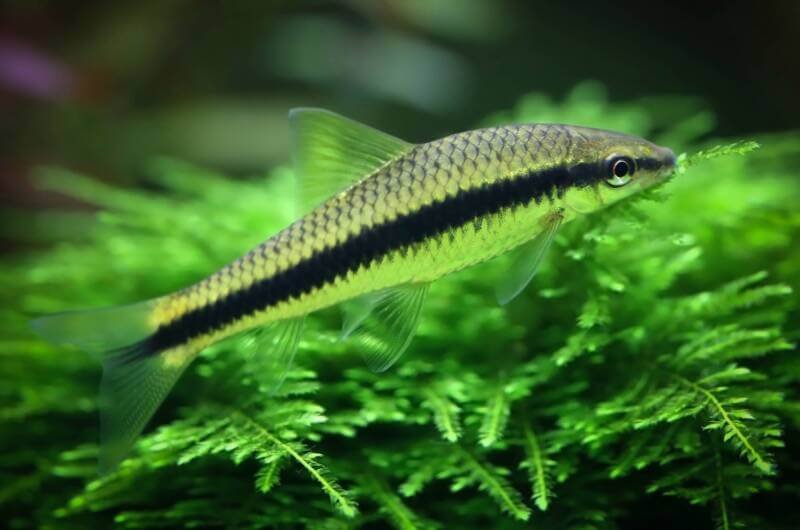
What algae will it eat? String algae, red algae, black beard algae, hair algae, fuzz algae
The slender, unassuming Siamese algae eater (SAE) is an alga devouring powerhouse. Happy to feast on multiple algae types, this fish will even attack beard algae, which other species will not do.
They reach around six inches (15 cm) in length when fully grown. They are constantly in motion and may bother timid fish with their activity level.
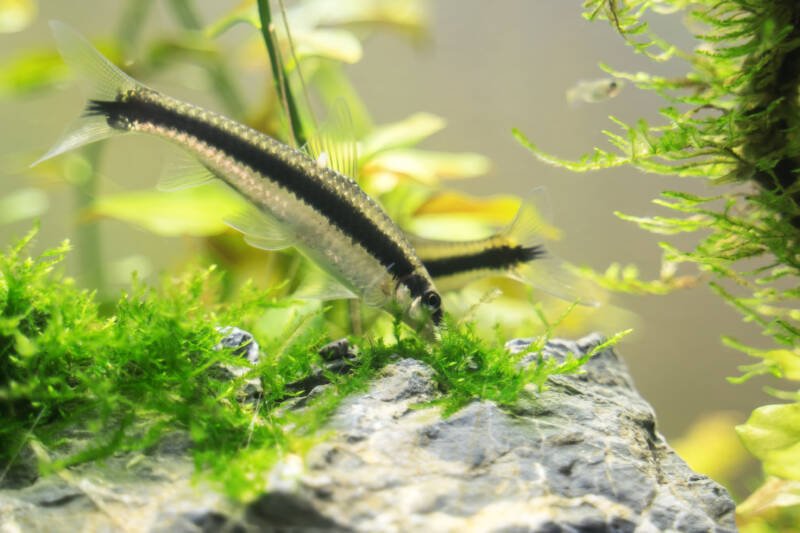
Keep them as a single specimen or in a group of at least five to spread out territorial aggression.
This fish needs warm water. If you keep them in an outdoor pond, you need to bring them indoors for colder months (unless you are in a year-round warm climate).
Take care to ensure that you are getting a true Siamese algae eater. There are similar breeds, such as the Chinese algae-eater or Siamese flying fox, which will grow quite large or not suit your algae-eating needs.
5. Mystery Snail (Pomacea brigesii)
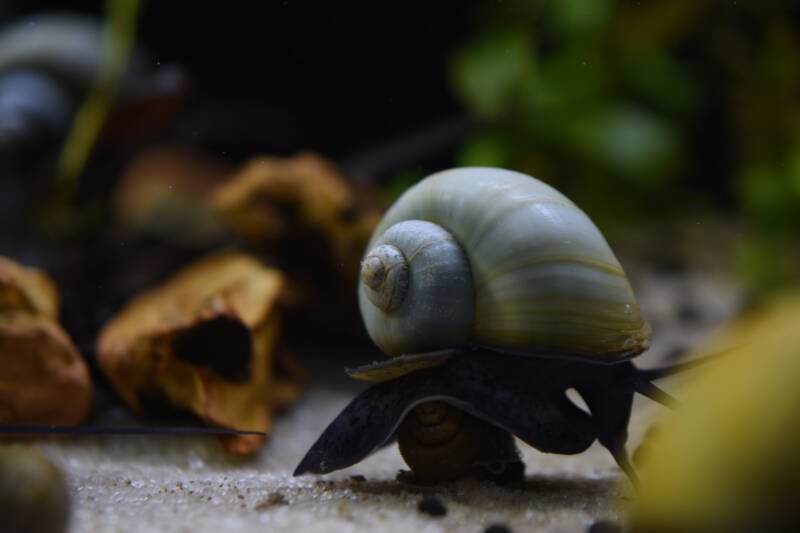
What algae will it eat? Hair algae, blue-green algae, free-floating algae
Mystery snails, also known as apple snails, are hardy and popular members of home aquarium cleanup crews.
Take care to ensure you are getting the correct species of mystery snail. There are multiple species under the same name, some of which are pests, and their import is restricted.
Your tiny mystery snail will eat algae growing on the tank glass, substrate, and even plants. However, take care when introducing them to planted aquariums as they can take a liking to the plants themselves.
These snails have interesting behaviors, such as floating at the surface, breathing air through a special organ, and burrowing into the substrate. Their many colors make them a beautiful addition to your tank.
6. Cherry Shrimp (Neocaridina heteropoda)
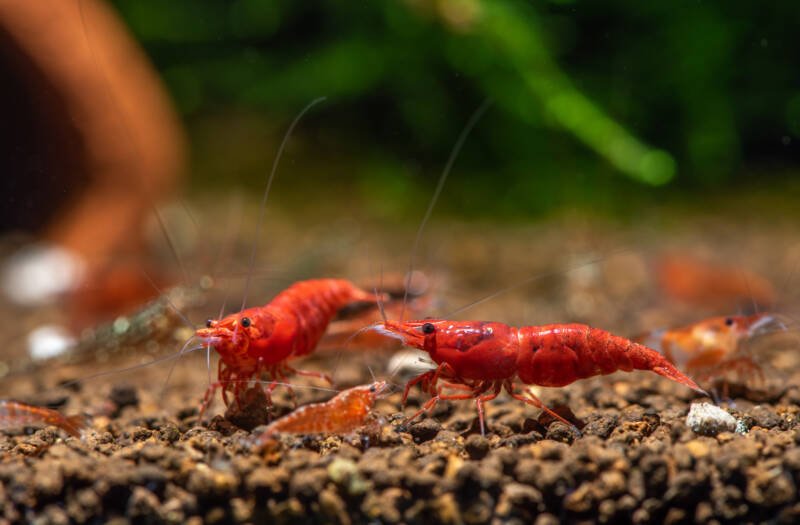
What algae will it eat? Soft green algae, biofilm, some hair algae, and thread algae
Cherry shrimp are a dwarf species that come in a graded range of bright red colors. They are active omnivores that will continuously graze on algae in your tank.
Their preference is for soft green algae and biofilm, but they will take on hair algae and thread algae to an extent. These shrimp need a cycled tank with established algae growth.
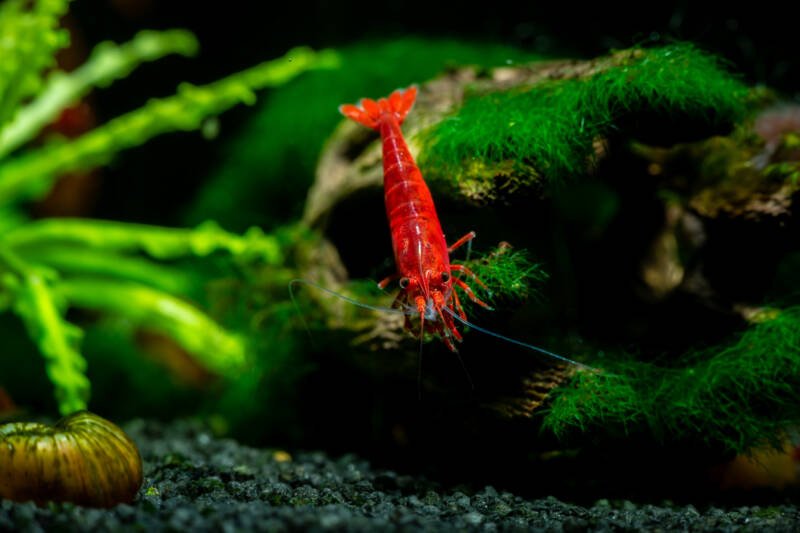
Their size and peaceful nature mean that you should avoid placing them with overly aggressive fish.
They do well in groups of at least ten and will gather to feed off a choice location. Make sure that the tank size is sufficient for the number of shrimp you have, otherwise, they could become territorial.
7. Clown Pleco (Panaque maccus)
What algae will it eat? Green algae, brown algae
For a smaller bottom-dweller, consider the clown pleco. This 3.5-inch (9 cm) fish brings bright orange and black color to the bottom of the tank.
The clown pleco needs a mature tank with an established algae growth. Driftwood, rocks, and plants in their environment will encourage this growth.
The clown pleco will graze heavily on the driftwood and, by doing so, will consume some algae. They need frequent supplementary feedings with vegetable-based foods and the rare meaty treat.
These fish are peaceful and great for community tanks. They get along with others of their kind with only occasional squabbles among males.
Several species are marketed using the “clown pleco” name, so make sure you are getting the one you want. Some species are more aggressive, grow larger, and do not consume algae as well.
8. Amano Shrimp (Caridina multidentate)
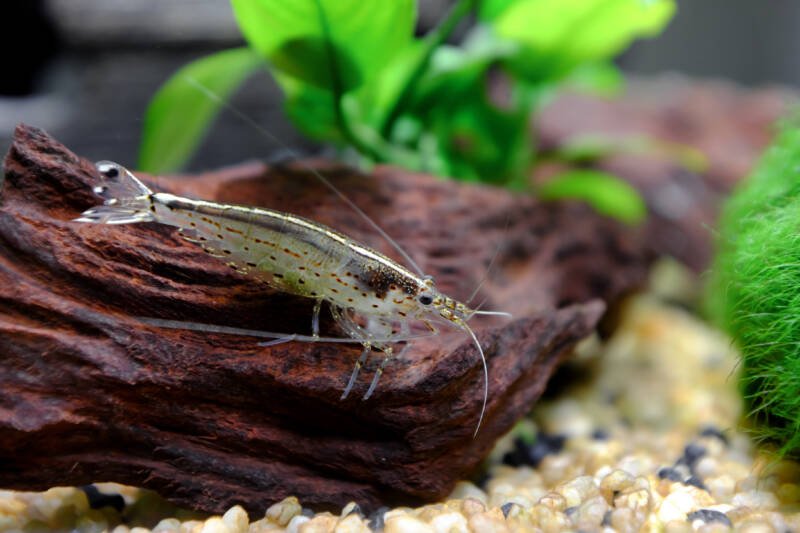
What algae will it eat? Black beard algae, hair algae, rhizoclonium algae, green algae, brown algae, green dust algae, fuzz algae, Oedogonium algae, free-floating algae
Any quick search regarding algae eaters is likely to list Amano shrimp as the top algae-eating shrimp.
These tiny creatures are meticulous algae cleaners for multiple aquarium surfaces.
While they may have trouble with glass-adhering algae, all other surfaces, even the delicate surfaces of leaves, are fair game. Plus, they feast on a wide range of common aquarium algae types.
Their small size is both a benefit and a concern. The benefit: they are perfect for nano tanks. In addition to its small size, this shrimp species has an incredibly low bioload.
The downside: their small size makes them vulnerable to predation from shrimp-loving species, so be cautious when pairing them in a community tank.
9. Ghost Shrimp (Palaemonetes paludosus)
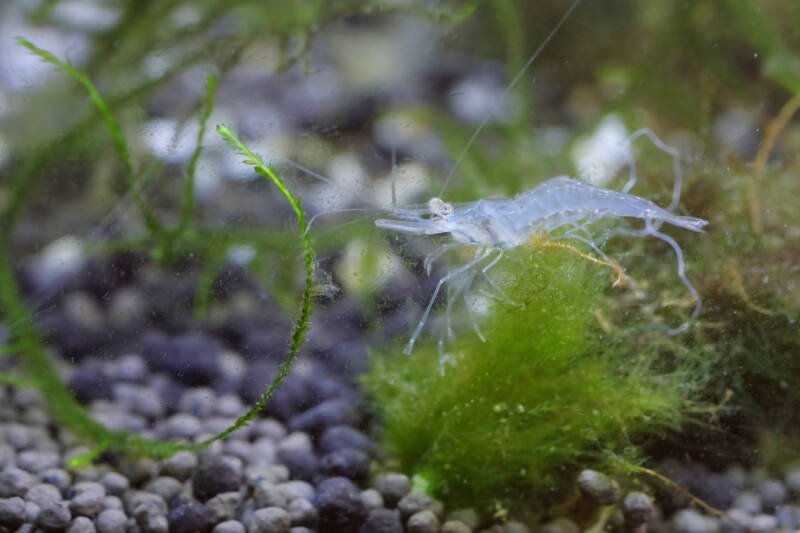
What algae will it eat? Brown algae, hair algae
The ghost shrimp is an active, fully transparent species with their organs clearly visible. They only reach around an inch and a half (3.8 cm) in length, so they are great for smaller tanks.
As they are strict bottom feeders, ghost shrimp will not eat algae that have attached to the glass or floating algae but will readily snack on soft algae growing along the bottom.
Place stones and other decorations in the tank to encourage algae growth. Ghost shrimp are gentle and can pair with other smaller, peaceful species.
They prefer dead or decaying foods, which means they will not go after your aquarium plants. The only time you may see this is if your shrimp are underfed.
10. Nerite Snail (Neritina natalensis)
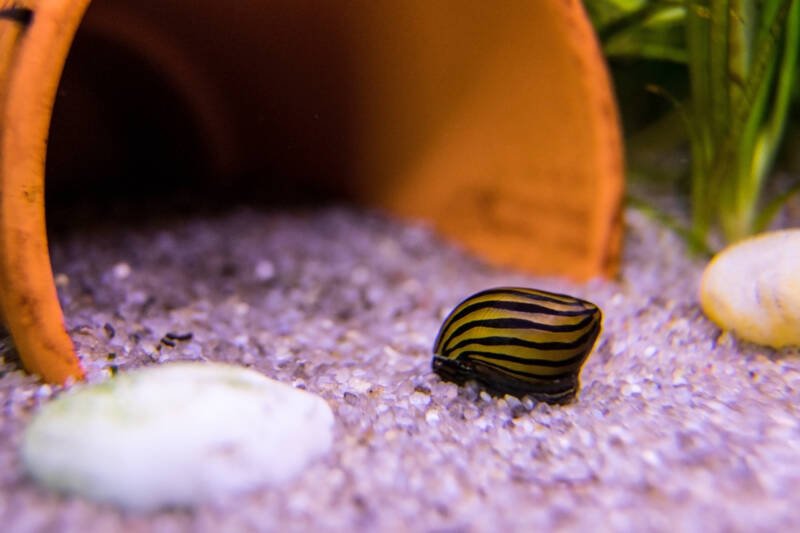
What algae will it eat? Green dust algae, green spot algae, hair algae, green algae, free-floating algae
With over 200 species from which to choose, there is a nerite snail for every tank.
These algae-eating snails have lovely patterns on their shells and are as hardy as it gets, capable of living in both fresh and saltwater.
They are small (only around an inch/2.5 cm in size), non-aggressive, and expert at removing green spot algae.
These active scavengers will devour biofilm and decaying plant matter as well, even removing algae from glass surfaces.
The downside: they are prolific egg layers. While the eggs will not hatch in a freshwater tank, they will be everywhere.
These eggs can be difficult to remove but in a well-planted tank, which may not be much of an issue as they will naturally disappear.
11. Bamboo Shrimp (Atyopsis moluccensis)
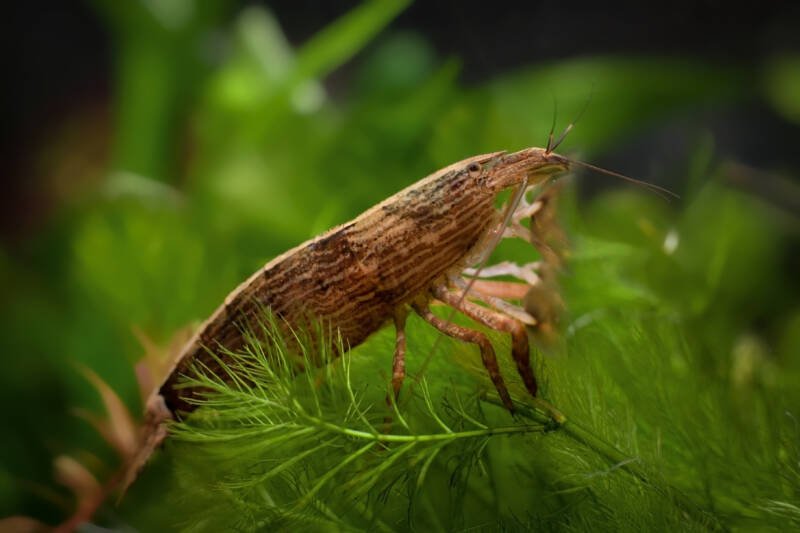
What algae will it eat? Free-floating algae
Bamboo shrimp are filter feeders. They use their unique, fan-shaped appendages to pull micro-algae and micro-organisms directly from the water column.
While they will not eat algae that have attached itself to surfaces in your aquarium, they are great for taking care of free-floating algae.
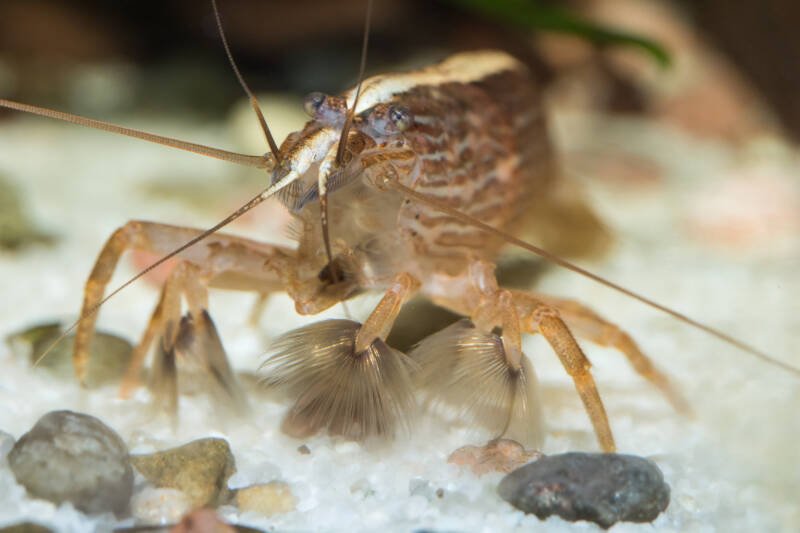
These freshwater shrimp reach a large three inches (7.6 cm) in size, so you can house them with larger fish without worrying that they will become a snack. Their peaceful nature allows varied pairings as well.
Two essential things in a tank with bamboo shrimp are live plants (which will create hiding spaces and encourage algae growth!) and sufficient water flow (to transport foods around the tank through the water column).
12. Mollies (Poecilia sphenops)
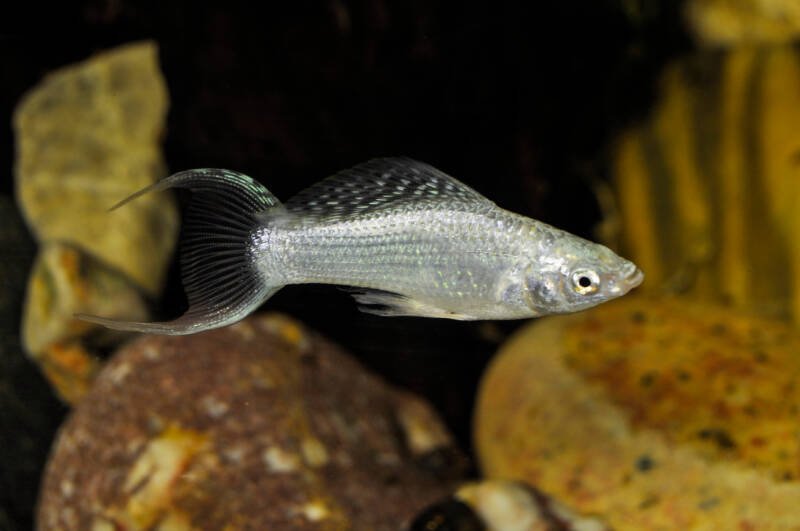
What algae will it eat? Fuzz algae, hair algae, Oedogonium algae
Molly fish are amazingly undemanding and easy to care for, making them great for beginners.
These live-bearing fish have been bred into so many color variations that finding a type that appeals to you and fits your tank will be a breeze.
These fish naturally include various types of algae in their diet, but it is not the sole source of their nutrients. In a home aquarium, they will tackle hair algae well, but you will need to supplement their diet for them to remain healthy.
Adding a group of at least four mollies to a cleanup crew can help maintain algae levels and control any blooms.
These fish need warm water that is alkaline and hard. Pair your mollies with fish needing similar conditions.
13. Hillstream Loach (Sewellia lineolate)
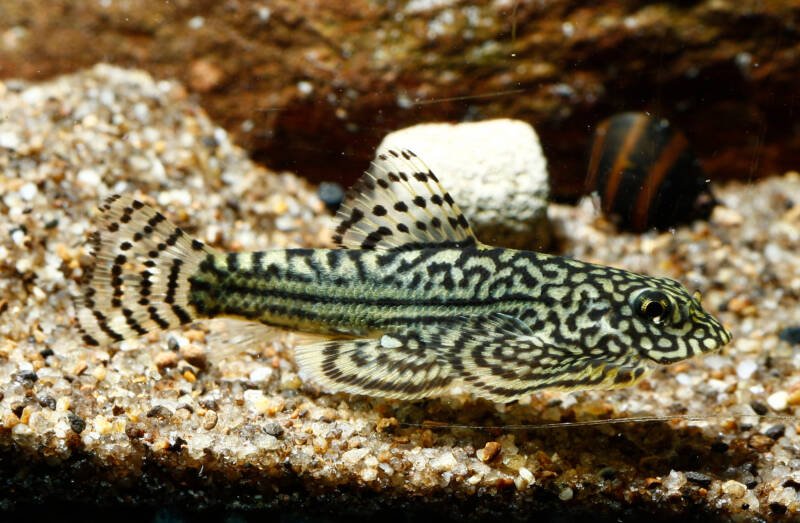
What algae will it eat? Brown algae
The sleek, hydrodynamic hillstream loach is built to hug the substrate in fast-moving, cool water streams. In captivity, they need these water conditions and will not thrive in a tropical tank.
These fish need a larger tank than you would expect for their small size. Larger tanks allow for the strong current flow and high oxygen levels this loach needs.
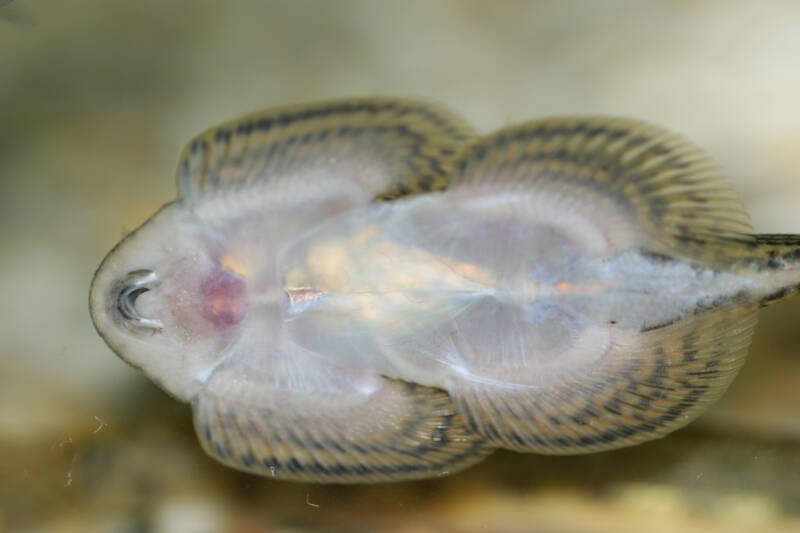
Keep them in a small group of three to four fish and provide plenty of smooth-sided hiding places along the tank bottom.
These hiding places are great spots for algae to grow. Hillstream loaches are scavengers that will readily snack on brown algae but will not touch hair, black beard, or green spot algae.
14. Rabbit Snail (Tylomelania sp.)
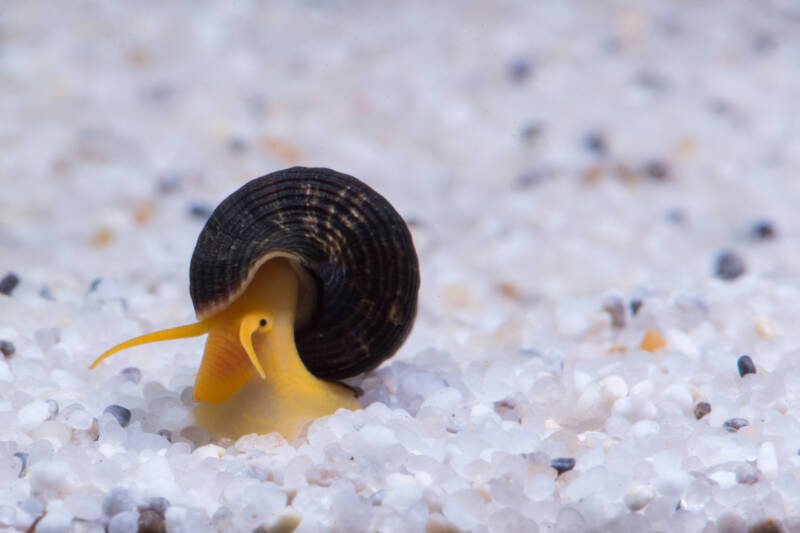
What algae will it eat? Green dust algae, free-floating algae
Rabbit snails are on the larger end of aquarium snail species, coming in anywhere between three and five inches (7 to 13 cm), depending on the species.
Their long antennae and colorful shells add visual interest to the tank.
They are active both in the daytime and nighttime, making them fun to watch. Maintain alkaline water conditions to keep their shells strong.
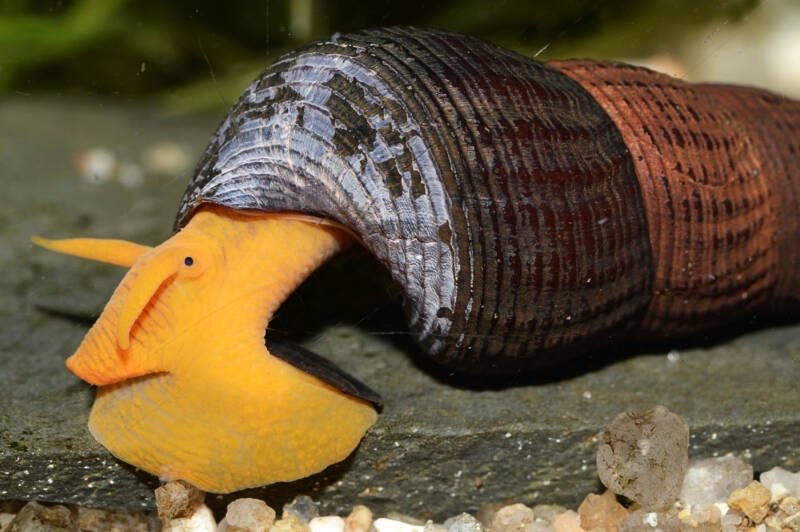
These snails will not munch on your sturdier aquarium plants but may take a bite or two out of delicate ones, such as java fern.
Algae, leftover fish food, and decaying plant matter are on the top of their food list, and they are experts at cleaning glass, decorations, and even the leaves of plants.
15. Florida Flagfish (Jordanella floridae)
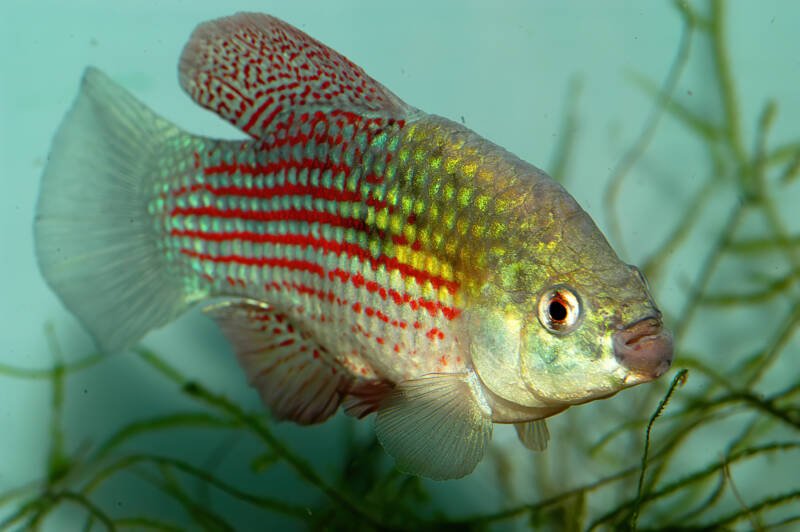
What algae will it eat? Hair algae, black beard algae
Also called the American flagfish, this species is an enthusiastic eater and is one of few freshwater fish species that will tackle black beard algae. They are efficient in keeping algae blooms under control.
Flagfish have stunning patterns on their scales that resemble the American flag. While they are fine in a group of their own, they are semi-aggressive toward other species and are best in a single species tank.
Keep a group of at least five fish and take care when housing multiple males.
These fish are hardy and easy to care for. Their size of 2.6” (6.5 cm) makes them a good fit for smaller tanks. In addition, they are excellent in planted tanks because they will not damage aquatic plants.
16. Malaysian Trumpet Snail (Melanoides tuberculata)
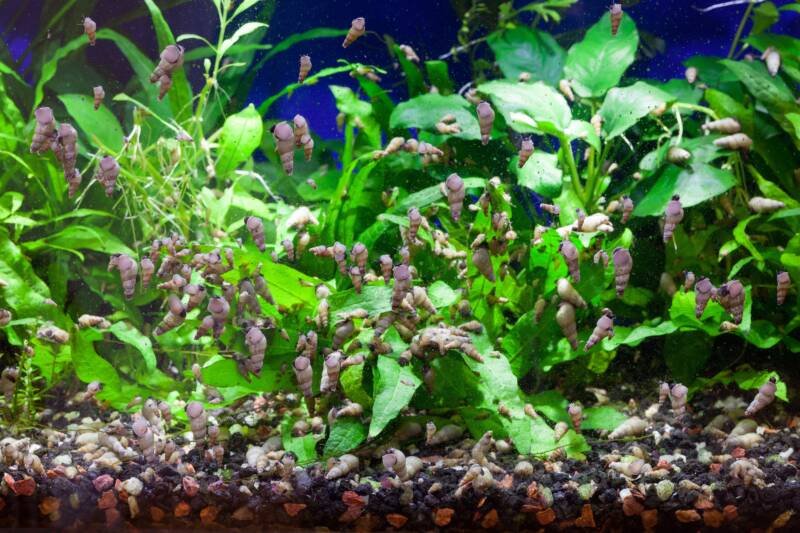
What algae will it eat? Free-floating algae, hair algae, green spot algae
The Malaysian trumpet snail (MTS) is another robust eater of algae in addition to uneaten food and detritus that can impact your tank’s water quality.
They are incredibly easy to care for and are suitable for beginners and experienced aquarists alike.
These livebearers burrow under the soil during the day and need a sandy substrate. This burrowing activity helps to aerate the soil, thereby preventing the buildup of toxic substances that can rapidly affect your tank and harm your fish.
As good as their cleaning skills are, MTS have a reputation for rapidly overpopulating the tank. Consider pairing them with a species that can take care of snail eggs to prevent this.
17. Spixi Snail (Asolene spixii)
What algae will it eat? Some aquarium algae, green hydra, free-floating algae
Spixi snails are scavengers that are just as happy eating algae as detritus.
While they are not the best algae-eaters out there, they have the added benefit of being able to eat hydra, which can have symbiotic algae attached to them.
These snails have swirled shells with unique striped patterns. This small species is well adapted to a nano tank if you are restricted in space.
Be aware that these snails are semi-aggressive and can prey on smaller snail species, much like the assassin snail. In addition, they can munch on softer aquarium plants, so pair them with tough leafed varieties.
18. Golden Nugget Pleco (Baryancistrus xanthellus)
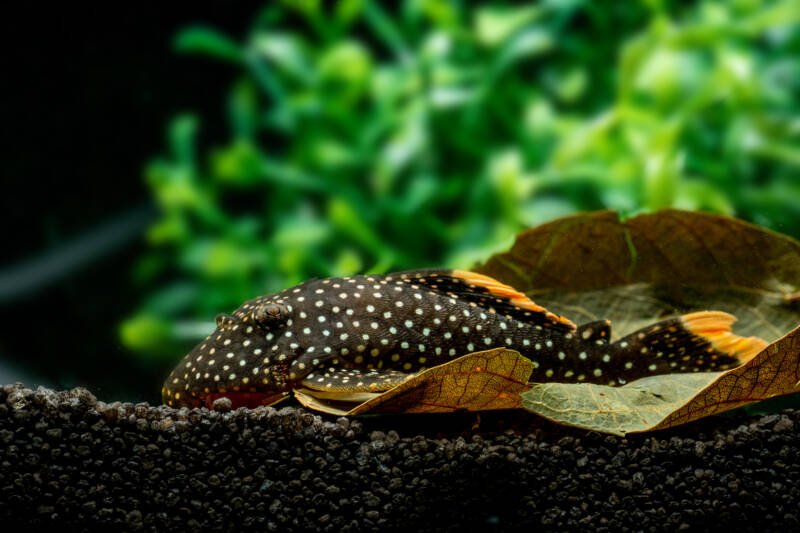
What algae will it eat? Green algae, brown algae
While most plecos blend in with their environment, the golden nugget pleco’s bright yellow spots stand out. The tips of their dorsal and caudal fins are a brilliant gold as well.
They are peaceful and suitable for beginners, although their 10-inch (25 cm) size requires a slightly larger tank than one might expect.
They will snack on leaves that drop from aquatic plants but will not harm the live plants themselves.
It has trouble eating algae from glass surfaces, so make sure driftwood, rocks, and plants are available on the tank bottom.
Avoid keeping them with other bottom dwellers, as the golden nugget may see the others as an intruder on its territory.
19. Whiptail Catfish (Rineloricaria spp.)
What algae will it eat? Green algae
These fish are great for peaceful community tanks. They are omnivores and efficient scavengers. While they do not heavily consume algae, they will graze on green algae in a large, well-established tank.
As algae are not the base of their diet, they will need supplementary feedings of vegetable and meaty foods, including brine shrimp and bloodworms.
They are large fish, needing a tank of 75 gallons (284 l) or more to house their four-inch (10 cm) frames.
The water should be cool, and they require a strong current and well-oxygenated water. As with the common pleco, the whiptail catfish produces a hefty amount of waste and requires a sturdy filtration system.
20. Rubber Lip Pleco (Chaetostoma milesi)
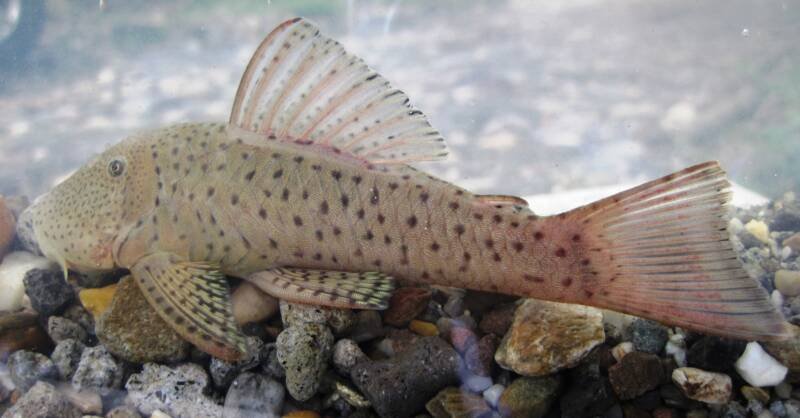
What algae will it eat? Green algae, brown algae, hair algae, black beard algae
The rubber lip pleco’s natural diet is primarily algae. Therefore, they will get to work on the algae in your tank.
In captivity, however, there is likely not enough algae in the aquarium to sustain them. These scavenging omnivores accept a variety of supplementary foods.
Rubber lip plecos do not grow large, reaching only seven inches (18 cm) as an adult, and are extraordinarily peaceful. Their olive coloration and high dorsal fin are attractive features.
Keep in mind that the current is strong in their native habitat and should be in the aquarium as well. Pair them with species that can tolerate the water flow and highly oxygenated water.
While they do not require driftwood in the tank, it is a good idea to include some.
Closing Thoughts
Remember that algae-eating fish are only one part of the solution to your algae problem.
Select the best fish for the algae you have but also ensure that you are taking the necessary steps to control algae in your tank.
Join the conversation! What are your favorite algae-eating fish, snails, or shrimp?